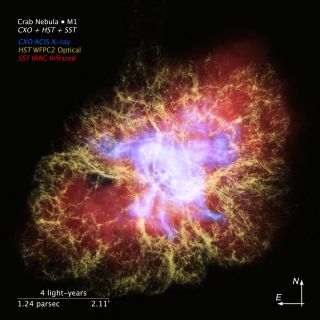Tour the colorful Crab Nebula with this stunning new 3D visualization – Space.com
A new 3D movie highlights the Crab Nebula, beginning with its location in the constellation Taurus and zooming in to show off its dynamic features.
Data from the Hubble Space Telescope, Spitzer Space Telescope and the Chandra X-ray Observatory allowed visualists to piece together the different processes occurring in the beautiful structure.
Viewers of the four-minute video get a glimpse of the pulsing, super-dense stellar corpse within the Crab Nebula. This pulsar, or rapidly-spinning neutron star, blasts out radiation with clockwork precision about 30 times per second, NASA officials said in a statement.
The video was unveiled Jan. 5 at the 235th meeting of the American Astronomical Society in Honolulu, Hawaii.
Video: Crab Nebula visualized using NASA’s ‘Great Observatories’ data
Related: Amazing views of the famous Crab Nebula

This video isn’t just a treat for the eyes – it also helps scientists gain a fuller understanding about the Crab Nebula’s world.
“Seeing two-dimensional images of an object, especially of a complex structure like the Crab Nebula, doesn’t give you a good idea of its three-dimensional nature,” said Frank Summers, visualization scientist from the Space Telescope Science Institute (STScI) in Baltimore, Maryland, in the statement. His team developed the movie.
“With this scientific interpretation, we want to help people understand the Crab Nebula’s nested and interconnected geometry. The interplay of the multiwavelength observations illuminate all of these structures. Without combining X-ray, infrared and visible light, you don’t get the full picture.”
“Multiwavelength” means that Hubble, Spitzer and Chandra view different types of activity with their instruments, which are each fine-tuned to different wavelengths on the electromagnetic spectrum, explained NASA.
The pulsar at the center of the Crab Nebula contains certain structures and processes that generate particular wavelengths of light. That’s why 3D movies like this one are as helpful as they are fun to watch.
Related: Cosmic Bat Nebula Photographed by ESO’s Very Large Telescope
The visualization is from a new generation of products being created by NASA’s Universe of Learning Program, an effort to connect scientific work with lay audiences. This particular video aims to highlight the reasons behind observing space through different wavelengths.
The Infrared Processing and Analysis Center (IPAC) at Caltech in Pasadena, California, and the Center for Astrophysics in Cambridge, Massachusetts, also helped produce the video.
Amateur astronomers can get their own good view of the Crab Nebula in January, Hubble officials said. The object was bright enough for 18th century technology to discover it, and astronomer Charles Messier even mistook the nebula for Halley’s Comet. That’s why the Crab Nebula is also known as Messier 1 (M1).
More importantly, the supernova that created the nebula wowed societies across the planet when it appeared in Earth’s skies centuries ago. Chinese astronomers made a record of the “guest star” appearance in 1054. The supernova was visible in the daytime sky for about a month, according to NASA; it wasn’t until the 20th century that astronomers realized that both M1 and the historic supernova were the same object.
As unique as this celestial object already is from humanity’s perspective, the Crab Nebula is even more peculiar than your run-of-the-mill supernova. Hubble officials shared in the video description that the object is a pulsar-wind nebula.
A traditional nebula has a blast wave that scorches material around it, but the gas and dust in a pulsar wind nebula is heated by radiation to a lower temperature.
The use of many instruments is allowing researchers to wrap their heads around this special stellar corpse.
“It is truly via the multiwavelength structure that you can more cleanly comprehend that it’s a pulsar wind nebula,” Summers added in the statement. “This is an important learning objective. You can understand the energy from the pulsar at the core moving out to the synchrotron cloud, and then further out to the filaments of the cage.”
Follow Doris Elin Urrutia on Twitter @salazar_elin. Follow us on Twitter @Spacedotcom and on Facebook.







